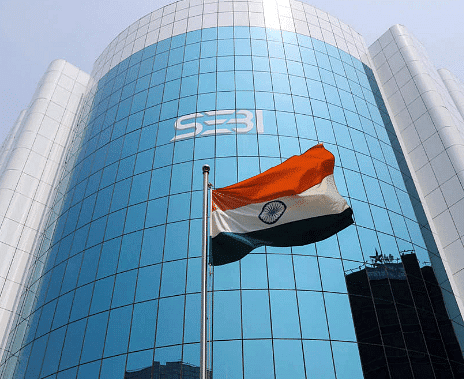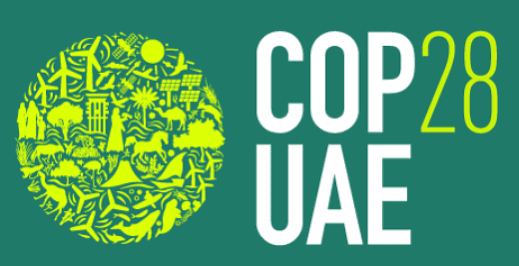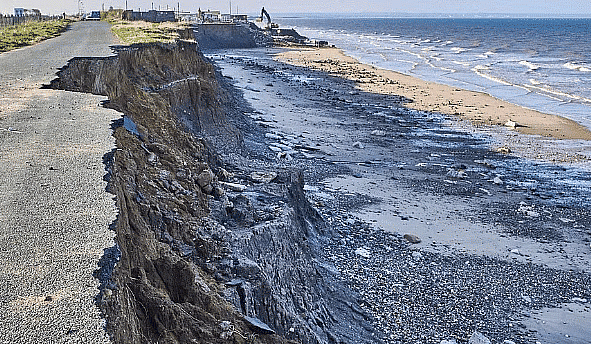Environment and Ecology: December 2023 UPSC Current Affairs | Environment for UPSC CSE PDF Download
Limitations of CCS and CDR
Context: The preliminary resolutions adopted during COP28 in Dubai have focused on the reduction and elimination of carbon emissions through the utilization of carbon capture and storage (CCS) and carbon dioxide removal (CDR) technologies.
What are ‘unabated’ fossil fuels?
- Unabated - Doing nothing to reduce the carbon dioxide (CO2) and other greenhouse gases that are released from the burning of coal, oil, and natural gas.
- According to IPCC, unabated fossil fuels are those “without interventions that substantially reduce GHG emissions.
- At COP28, the term “unabated fossil fuels” has come to mean the combustion of these fuels without using CCS technologies to capture their emissions.
- Abated - Attempts to decrease the release of polluting substances to an acceptable level.
What are CCS and CDR?
- CDR and CCS stand as separate entities, although certain CO2 removal methods, like direct air capture, might utilize the same capture techniques or infrastructure for long-term storage as conventional CCS.
- Carbon capture and storage (CCS) entails technologies designed to capture CO₂ from emission sources before its release into the atmosphere. These sources span from the fossil fuel industry (where coal, oil, and gas are combusted for power generation) to industrial processes such as steel and cement production. The process includes three key stages: capturing the produced CO2, transporting the captured CO2, and storing it deep underground.
- Carbon Dioxide Removal (CDR) employs various technologies, practices, and methods to extract CO2 from the atmosphere through deliberate human intervention. CDR sequesters CO2 from the air and retains it for extended periods in vegetation, soils, oceans, rocks, saline aquifers, depleted oil wells, or long-lasting products like cement. It encompasses natural approaches like afforestation or reforestation, as well as technological methods such as direct air capture, where machines imitate trees by absorbing CO₂ and depositing it underground. Examples include enhanced rock weathering and BECCS (Bioenergy with carbon capture and storage).
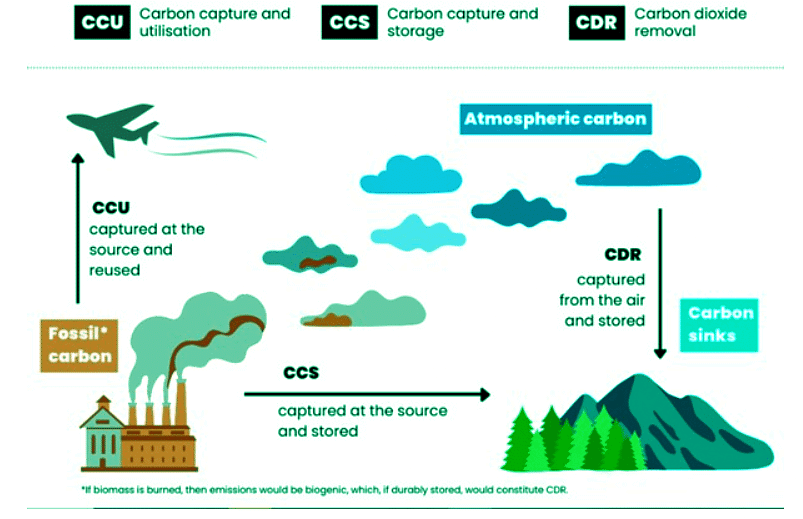
How well do CCS and CDR need to work?
- According to 6th Assessment Report (AR6) of UN’s IPCC, climate mitigation relies a lot on the use of CDR in achieving the goal of limiting the world’s average surface temperature increase to 1.5 degrees C with no or limited overshoot.
- If CO₂ emissions continue at current levels, we will have a 50% chance of exceeding 1.5 degrees C compared to pre-industrial levels in 7 years.
- There is more than a 50% chance of limiting warming to 1.5 degrees C assuming if the world can sequester 5 billion tonnes of CO₂ by 2040 which is more than India emits currently every year.
- Direct mitigation refers to reducing our reliance on fossil fuels with renewable energy sources like solar and wind power.
What are the limitations of CCS?
- Limited technology development – Despite several decades of development, CCS has not proven its viability at a large scale.
- Higher costs – Attaching a carbon capture device to a coal plant is more expensive than replacing it with a combination of wind, solar, and batteries.
- Increased energy requirements – CCS creates additional energy needs for the transportation and long-term storage of captured carbon.
- Potential for GHG emissions – Relying on CCS could potentially release an additional 86 billion tonnes of greenhouse gases into the atmosphere from 2020 to 2050, as revealed by a Germany-based climate science and policy institute.
- Underperformance – According to a 2022 study by the Institute for Energy Economics and Financial Analysis (IEEFA), most of the 13 flagship CCS projects worldwide have either failed outright or performed below expectations.
What are the limitations of CDR?
- Affect land rights – Higher land demand for planting trees and deploying large-scale CDR methods deprive indigenous communities of their land rights.
- Threaten food security – It compete with other forms of land-use, like agriculture that is crucial for ensuring food security.
- Affect biodiversity – It might alter existing land usage and thereby impact habitat and survival of different organisms.
- Impact of climate change mitigation – Deploying CDR technologies in large tracts of land might counteract from using land to generate renewable energy resources.
- For example, the 2023 ‘Land Gap’ report shows over reliance of government on land-based CDR to offset fossil fuel emissions thereby shifting their mitigation burden away from reducing fossil fuel use.
- Uncertain future – There is need to identify viable and scalable CDR methods and to figure out who will pay for CDR at scale in the future.
India’s Coal Plants: SO2 Emission Control
Context: According to an analysis by the Centre for Research on Energy and Clean Air (CREA), India's coal plants encounter difficulties in managing sulphur dioxide (SO2) emissions. The primary concerns involve the limited implementation of suggested technologies and widespread extensions of deadlines.
Key Findings:
- Installed Capacity: Only a combined capacity of 16.5 Gigawatts (GW) of coal plants have installed FGDs and CFBC boilers equivalent to 5.9 GW across India.
- FGD Implementation: 92% of the country's coal power plants operate without FGDs.
- Emission Control Derailment: Blanket extension of deadlines without progress checks by MoEF&CC and CPCB [Central Pollution Control Board] contributed to emission control derailment.
- Emission Standards: Introduced in 2015 for regulating PM, SO2, NOx, and Hg [Mercury] emissions.
- Deadline Extensions: Extended multiple times for units in Delhi-NCR and most other units across the country.
- Installed Capacity Breakdown: India's energy generation installed capacity: 425 GW, with coal holding a predominant share (48.6%).
Categorization of Power Plants for FGD Installation
- Coal power plants situated within a 10-kilometer vicinity of the NCR and cities with a population exceeding one million.
- Power plants located within 10 kilometers of critically polluted regions or non-attainment cities.
- All other power plants across the nation, constituting the majority.
Way Forward:
- Accelerate FGD Implementation: Prioritize and incentivize for compliance.
- Expand CFBC Implementation: Provide support for broader adoption.
- Stricter Enforcement: Strengthen monitoring with penalties for non-compliance.
- Research and Development (R&D): Invest in advanced tech for sustainable power generation.
Saiga Antelope

Context: The International Union for Conservation of Nature (IUCN) has changed the classification of the Saiga Antelope from 'Critically Endangered' to 'Near Threatened'.
About Saiga Antelope
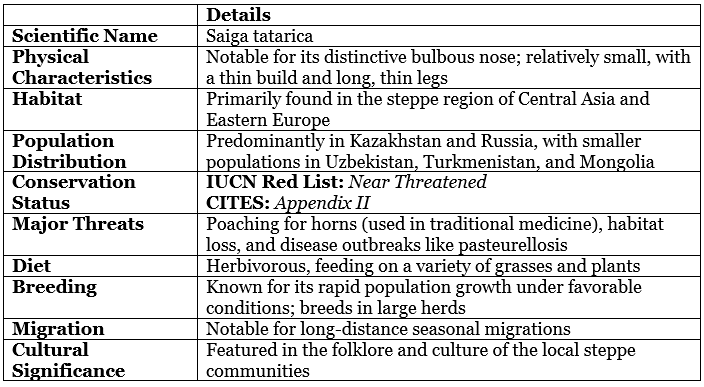
28th Conference of Parties To the UNFCCC
Context: The United Nations Framework Convention on Climate Change (UNFCCC) convened the 28th Conference of Parties (COP28) in Dubai, United Arab Emirates, recently.
What are the Key Highlights of the COP28?
- Loss and Damage (L&D) Fund: Member nations at COP28 agreed to operationalize the Loss and Damage (L&D) fund, which aims to compensate countries dealing with climate change impacts. The World Bank will act as the "interim host" for four years, in line with UNFCCC and the Paris Agreement. Developing countries are eligible to apply, with an emphasis on a specified percentage for Least Developed Countries and Small Island Developing States.
- Global Stocktake (GST) Text: The fifth iteration of the Global Stocktake (GST) text was introduced at COP28, which outlines steps to maintain global temperature rise within 1.5 degrees Celsius. These steps include tripling renewable energy capacity, phasing down unabated coal power, transitioning from fossil fuels, and more.
- Renewables and Energy Efficiency Pledge: Countries agreed to work together to triple the world’s installed renewable energy generation capacity to at least 11,000 GW by 2030 and to double the global annual rate of energy efficiency improvements to over 4% each year until 2030.
- Global Cooling Pledge: Signed by 66 national governments, aiming to reduce cooling-related emissions across all sectors by at least 68% globally by 2050 compared to 2022 levels.
- Climate Finance: There's a call for wealthy nations to provide USD 500 billion in 2025 for climate finance to developing countries under the New Collective Quantified Goal (NCQG). The goal is to set a new collective quantified goal before 2025, starting at a floor of USD 100 billion per year.
- Global Goal on Adaptation (GGA): A draft text was introduced to enhance climate change adaptation, focusing on critical issues like climate-induced water scarcity, resilient food production, and climate-related health impacts.
- Nuclear Energy Declaration: A declaration was launched aiming to triple global nuclear energy capacity by 2050, endorsed by 22 national governments, to advocate for incorporation of nuclear energy in energy lending policies.
- Powering Past Coal Alliance (PPCA): Welcomed new national and subnational governments and emphasized cleaner energy alternatives, aiming to transition from unabated coal power generation to clean energy.
- Coal Transition Accelerator: Introduced to facilitate transitions from coal to clean energy through knowledge-sharing, policy design, and financial support.
- Coalition for High Ambition Multilevel Partnership (CHAMP): Signed by 65 national governments, committing to enhance cooperation with subnational governments in planning and implementing climate strategies.
- India-Led Initiatives: India launched the Global River Cities Alliance (GRCA) and the Green Credit Initiative at COP28 to focus on sustainable river-centric development, climate resilience, water conservation, afforestation, and incentivizing environmental activities for corporations and private companies.
Second Phase of LeadIT

Context: At the Leadership Group for Industry Transition (LeadIT) Summit 2023 held during the Conference of Parties (COP 28) in the United Arab Emirates and co-hosted by India and Sweden, the Ministry of Environment, Forest and Climate Change unveiled the three foundational principles for the second phase of LeadIT (2.0).
What is the Leadership Group for Industry Transition (LeadIT)?
About:
- LeadIT is a global initiative that aims to accelerate the transition of challenging sectors such as steel, cement, chemicals, aviation, and shipping to low-carbon pathways.
- The LeadIT gathers countries and companies that are committed to action to achieve the Paris Agreement.
- It was launched by the governments of Sweden and India at the United Nations Climate Action Summit in 2019 and is supported by the World Economic Forum.
- The LeadIT Secretariat is responsible for managing the work of the Leadership Group.
Members:
- LeadIT, boasting 38 members, encompasses countries and companies. Notably, India is an active participant.
- LeadIT members subscribe to the notion that energy-intensive industries can and must progress on low-carbon pathways, aiming to achieve net-zero carbon emissions by 2050.
Key Highlights of the Second Phase of LeadIT:
Objective
- The primary aim is to foster policy creation and regulatory frameworks supporting an inclusive industry transition through collaborations between public and private sectors. This initiative seeks to gather resources, facilitate knowledge exchange, and expedite pathways toward achieving net-zero emissions from industries by 2050.
Pillars of LeadIT:
Global Forum for an Equitable Industry Transition:
- This pillar focuses on maintaining an ongoing dialogue and collaboration between governments and industries. It is dedicated to sustaining LeadIT's engagement with various international bodies such as UN Climate Action and UNFCCC COP presidencies. Its primary objectives are knowledge dissemination among members and vigilant monitoring of the transition's progress.
Technology Transfer and Collaborative Development:
- This pillar emphasizes the facilitation of business-to-business technology transfers and the establishment of national institutions for fostering innovation.
Industry Transition Partnerships:
- The LeadIT Secretariat supports its members in establishing industry transition partnerships, especially in emerging markets and developing economies. These partnerships involve the coordination and strengthening of technical and financial international support to maximize effectiveness. The ultimate goal is to create favorable conditions for a series of viable low-carbon industrial projects.
Diel Vertical Migration and Carbon Sequestration
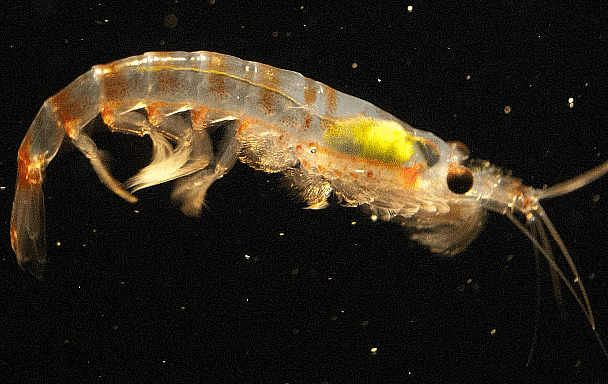
Context: Scientific observations indicate that Diel Vertical Migration contributes to Carbon Sequestration.
What is Diel Vertical Migration?
- Diel Vertical Migration stands as the Earth's most extensive daily migration of living organisms, involving the movement of deep-sea creatures, like zooplankton, on a regular basis.
- These creatures ascend to the surface during the night and descend to deeper levels during the day, a behavior aimed at foraging for food while avoiding predators.
- Their vertical movement serves as a strategic survival tactic.
What is Carbon Sequestration
- Carbon Sequestration denotes the process of capturing and retaining carbon dioxide (CO2) to prevent its release into the atmosphere, thereby curbing its contribution to global warming and climate change.
- It encompasses the long-term storage of carbon in various reservoirs such as plants, soils, geological formations, and the ocean, occurring both naturally and due to human-induced activities.
Types of Carbon Sequestration
- Terrestrial Carbon Sequestration: This process involves the absorption of CO2 from the atmosphere by trees and plants via photosynthesis, storing carbon in soils and various forms of biomass (such as tree trunks, branches, foliage and roots).
- Geological Carbon Sequestration: CO2 can be stored in oil reservoirs, gas reservoirs, unmineable coal seams, saline formations and shale formations rich in organic content.
- Ocean Carbon Sequestration: Oceans play a significant role in absorbing, releasing and storing considerable amounts of CO2 from the atmosphere. This occurs through two methods:
- Enhancing the productivity of ocean biological systems via Iron fertilization
- Iron fertilization involves adding iron to parts of the ocean that are low on this nutrient.
- Iron acts as a kind of "spark" for phytoplankton, tiny plant-like organisms in the ocean.
- When these phytoplankton get the iron they need, they grow and multiply, using up carbon dioxide from the atmosphere during photosynthesis.
- This process helps reduce the amount of carbon dioxide in the air, which is good for the environment.
- Injecting CO2 into the deep ocean.
How Diel Vertical Migration helps in Carbon Sequestration?
- Diel Vertical Migration (DVM) plays a role in carbon sequestration by moving carbon from the surface of the ocean to deeper levels.
- Tiny sea creatures, like zooplankton, come up to the surface at night to eat phytoplankton.
- When they swim back down during the day, they poop and release waste particles.
- These waste particles sink deep into the ocean, carrying carbon with them.
- This helps move carbon from the surface to the deep sea, where it can stay trapped for a long time, contributing to carbon storage and helping regulate the Earth's carbon cycle.
UNEP’s Action Plan for Cooling Sector

Context: The United Nations Environment Programme (UNEP) has put forward a strategy designed to notably decrease emissions from the worldwide cooling sector, detailed in its latest report named “Keeping it Chill: How to meet cooling demands while cutting emissions.”
- This endeavor holds promise to significantly alter the projected 2050 greenhouse gas emissions, aiming for a reduction of up to 60%.
- The publication aligns with the Global Cooling Pledge, a collaborative effort between the United Arab Emirates as the host of the Conference of Parties (COP28) and the Cool Coalition.
Note
- The Cool Coalition is a global network of partners working to provide efficient, climate-friendly cooling for all.
- The UNEP launched the Cool Coalition at the First Global Conference on Synergies between the 2030 Agenda for Sustainable Development Goals and the Paris Agreement.
- India is a member of the Cool Coalition.
What is the Proposed Action Plan by UNEP for Sustainable Cooling?
Nature-Inspired Solutions:
- The suggested measures involve passive cooling techniques such as shading, ventilation, insulation, green roofs, and reflective surfaces, as well as reintroducing natural elements to urban environments.
- Passive cooling methods aim to diminish reliance on mechanical cooling, thus conserving energy and curbing emissions.
Enhanced Efficiency Standards:
- Highlighting the significance of employing high-efficiency technologies and practices for cooling appliances like air conditioners, refrigerators, and fans.
- Utilizing more energy-efficient cooling technologies can reduce both energy consumption and emissions from cooling devices, resulting in cost savings for users and utilities.
Refrigerant Phasedown:
- This strategy entails utilizing alternative substances like hydrocarbons, ammonia, or carbon dioxide in cooling devices instead of hydrofluorocarbons (HFCs), which are potent greenhouse gases.
- HFCs, categorized as "super-pollutants," possess significant greenhouse gas properties, trapping heat hundreds to thousands of times more than carbon dioxide.
- Despite their considerable impact, HFCs are short-lived climate pollutants, with an average atmospheric lifespan of 15 years.
- Adoption of low-global warming potential refrigerants can reduce the direct emissions from cooling devices and aid in the gradual phase-down of HFCs following the Kigali Amendment to the Montreal Protocol.
- Encourages an expedited phasedown of climate-warming refrigerants and air conditioning technologies.
Why Address the Cooling Sector?
- The cooling sector plays a crucial role in combating rising temperatures, ensuring food safety, industrial cooling processes, and driving productive economies.
- However, without intervention, the growing demand for cooling equipment could lead to a substantial increase in electricity consumption and emissions.
- The cooling sector accounts for a substantial 20% of global electricity consumption.
- If current policies continue, the installed capacity of cooling equipment globally will triple, resulting in a more than doubling of electricity consumption by 2050.
- This could lead to emissions between 4.4 billion and 6.1 billion tonnes of carbon dioxide equivalent (CO2e) in 2050, accounting for over 10% of global projected emissions that year.
What are the Benefits of Sustainable Cooling?
- Passive cooling techniques and efficient cooling equipment can save consumers USD 17 trillion between 2022 and 2050.
- It is projected to reduce peak power requirements by 1.5-2 terawatts (TW), avoiding substantial power generation investments.
- Increasing the adoption of low-global warming potential technologies in new equipment and effectively managing refrigerant life cycles can reduce HFC emissions by 50% in 2050.
- Decarbonizing the power grid can further reduce sectoral emissions by 96%.
What are the Initiatives Related to Sustainable Cooling?
Global:
National Cooling Action Plans (NCAPs):
- Presently, more than 40 countries, including India, have developed NCAPs, and 25 others are at various stages of preparing theirs as well.
- Though India and China have included implementation mechanisms in their NCAPs, the rollout has been slow.
Global Cooling Pledge:
- At the bthe United Nations Framework Convention on Climate Change, the host country United Arab Emirates and the Cool Coalition launched the Global Cooling Pledge.
- Over 60 countries signed up to the Pledge with commitments to reduce the climate impact of the cooling sector.
Kigali Amendment Acceleration:
- The Kigali Amendment is an international agreement to reduce the production and consumption of HFCs.
- The amendment is part of the Montreal Protocol on Substances that Deplete the Ozone Layer.
- The Kigali Amendment aims to reduce HFC production and consumption by 80–85% by 2047.
- This is expected to prevent the emissions of up to 105 billion tonnes of CO2 of greenhouse gases, avoiding up to 0.5 degree Celsius of global temperature rise by 2100.
India:
- India Cooling Action Plan (ICAP).
- Bureau of Energy Efficiency (BEE) Star Rating Programme.
Coastal Erosion
Context: The Minister of State for Environment, Forest, and Climate Change provided insights into alterations along the entire Indian coastline. This information was derived from multi-spectral satellite images and field-surveyed data spanning the period from 1990 to 2016.
- The data was collected and analyzed by the National Centre for Coastal Research (NCCR), an entity under the Ministry of Earth Sciences, Government of India. NCCR is entrusted with the responsibility of conducting comprehensive research covering various domains such as Marine Pollutions, Coastal processes and Hazards, Coastal Habitats and Ecosystem, as well as Capacity Building and Training in these areas.
What are the Key Observations of NCCR Regarding Coastal Erosion?
- Some stretches of India’s shoreline are subject to varying degrees of erosion due to natural causes or anthropogenic activities.
- The shoreline analysis suggests that 34% of the coast is eroding, 28% is accreting and 38% is in a stable state.
- The state-wise analysis suggests that in the West Bengal (63%) and Pondicherry (57%) coasts, erosion exceeds more than 50%, followed by Kerala (45%) and Tamil Nadu (41%).
- Odisha (51%) is the only coastal state which is having more than 50% of accretion.
- The receding coastline will cause loss of land/habitat and the livelihood of fishermen in terms of losing the space for parking boats, mending nets and fishing operations.
What Government Initiatives Address Coastal Erosion?
- Hazard Line Delineation: The Ministry of Environment, Forest & Climate Change (MoEFCC) has established the hazard line for the entire Indian coastline.
- This demarcation signifies alterations along the shoreline, encompassing factors such as sea-level shifts attributed to climate variations.
- It serves as a tool for Coastal States' agencies in Disaster Management, aiding in the formulation of adaptive and mitigative strategies.
- Inclusion in Coastal Zone Management Plans: The hazard line is integrated into the revised Coastal Zone Management Plans of Coastal States and Union Territories, sanctioned by the MoEFCC.
- Coastal Regulation Zone Notification, 2019: The MoEFCC has promulgated the Coastal Regulation Zone Notification, 2019, aimed at safeguarding and preserving coastal stretches and marine regions while ensuring the sustenance of livelihoods for fishing communities and local residents.
- Nevertheless, the regulations permit the installation of erosion control measures along the coast.
- No Development Zones (NDZ): The notification also designates various categories of coastal areas as No Development Zones to prevent encroachment and erosion along India's coastline.
- Flood Management Scheme: Executed by the Ministry of Jal Shakti, this scheme encompasses anti-sea erosion projects managed by State Governments using their resources, aligned with the respective state priorities.
- The Central Government provides technical, advisory, and promotional support to the states.
- Coastal Management Information System (CMIS): Initiated under the "Development of Water Resources Information System" Central Sector Plan Scheme, CMIS focuses on collecting near-shore coastal data. This information aids in planning, designing, constructing, and maintaining location-specific coastal protection structures for vulnerable coastal stretches.
- Coastal Erosion Mitigation: Implemented in locations like Puducherry and Chellanam in Kerala, these measures have contributed to the restoration and protection of coastal areas in Puducherry and the alleviation of flooding in Chellanam Fishing Village. Technical assistance has also been extended to coastal States for designing protective measures at vulnerable sites and formulating Shoreline Management Plans.
|
95 videos|231 docs|52 tests
|
FAQs on Environment and Ecology: December 2023 UPSC Current Affairs - Environment for UPSC CSE
| 1. What are the limitations of CCS and CDR? |  |
| 2. How can India's coal plants control SO2 emissions? |  |
| 3. What is the second phase of LeadIT? |  |
| 4. What is diel vertical migration and its relation to carbon sequestration? |  |
| 5. What is UNEP's Action Plan for the Cooling Sector? |  |


